
German postcard by Ross Verlag, no. 5308/1. Photo: H. Gärtner / SF / Eichberg-Film, Berlin. Hans Albers in Der Greifer/The Snatcher (Richard Eichberg, 1930).

German Postcard by Ross Verlag, no. 762. Photo: Ufa.
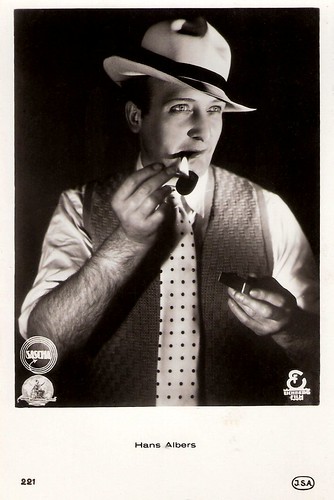
Dutch postcard by J.S.A., no. 221.
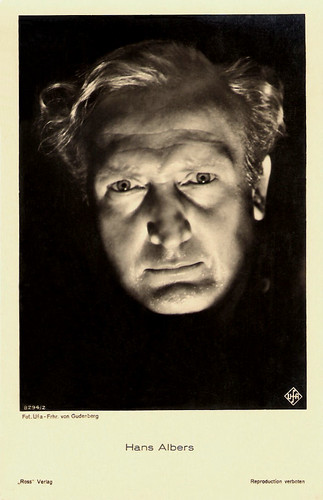
German Postcard by Ross Verlag, no. 8294/12, 1933-1934. Photo: Frhr. von Gudenberg / Ufa.

German postcard. by Ross Verlag, no. 7039/1, 1932-1933. Photo: Ufa. Publicity still for Der weiße Dämon/The White Demon (Kurt Gerron, 1932).

German postcard by Verlag und Drückerei Erwin Preuss, Dresden-Freital in the series Die neue farbige Filmstarkarte, Series 1, no. 13. Photo: Charlott Serda.
Blonde Hans
Hans Philipp August Albers was born in the North German port city of Hamburg in 1891. He was the son of a butcher and grew up in the Hamburg district of St. Georg. He was seriously interested in acting by his late teens and took acting classes without the knowledge of his parents.
He debuted as a stage actor in Bad Schwandau, followed by engagements in Frankfurt, Güstrow, Cologne and Hamburg. His first film part was in Jahreszeiten des Lebens/Seasons of Life (Franz Hofer, 1915).
Albers interrupted his career to serve in World War I, where he was badly wounded. After the war ‘der blonde Hans’ started as a comedic actor in various Berlin theatres. He appeared on-stage to great acclaim with Max Reinhardt's Deutsches Theater. Albers' breakthrough performance was that of a waiter in Ferdinand Bruckner's play 'Verbrecher' (Criminals).
His film roles ranged from Demetrius in Ein Sommernachtstraum/A Midsummer Night's Dream (Hans Neumann, 1924) to the title character in Rasputins Liebesabenteuer/Rasputin (Martin Berger, 1928). In Weimar Berlin, he began a relationship with half-Jewish actress Hansi Burg in 1925. She was the daughter of his acting teacher Eugen Burg.
Albers stopped working in theatre to distance himself from the Hitler regime, but the Nazis forced him in 1935 to end his relationship with Hansi Burg, who in 1938 emigrated to England via Switzerland. They secretly remained a couple with him even managing to send her financial support. In 1944 Eugen Burg would be killed in the concentration camp Theresienstadt. Hansi Burg returned to Germany and Albers in 1946. Hans and Hansi would live together until his death in 1960.
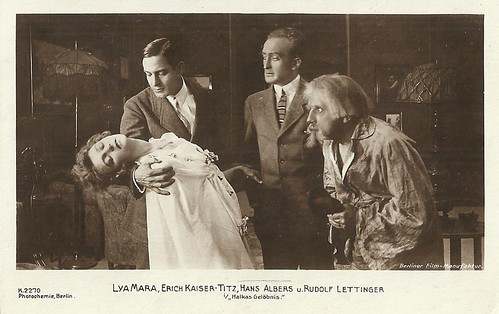
German postcard by Photochemie, Berlin, no. K. 2270. Photo: Berliner Film-Manufaktur. Lya Mara, Erich Kaiser-Titz, Hans Albers and Rudolf Lettinger in the German silent film Halkas Gelöbnis (H. Fredall, 1918). This postcard is one of a set of three cards that Photochemie issued on the film.
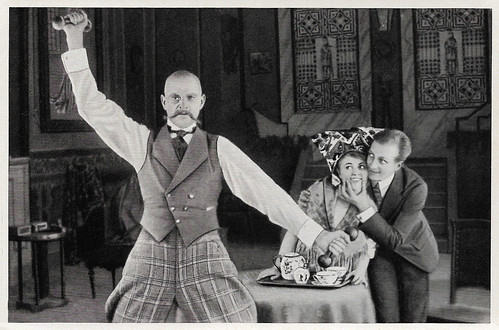
German collectors card by Ross Verlag in the series Vom Werden Deutscher Filmkunst - Der Stumme Film, picture no. 38, group 43. Photo: Paul Westermeier, Hanne Brinkmann and Hans Albers in Baroneßchen auf Strafurlaub/Little Baroness on Punishment Holiday (Otto Rippert, 1917). Caption: "Paul Westermeier 'hantelt', Hans Albers darf in einer kleinen Nebenrolle Hanne Brinkmann in die Wange kneifen". (Paul Westermeier 'works out', Hans Albers - in a small secondary role - is allowed to pinch Hanne Brinkmann in the cheek.)

Austrian postcard by Iris Verlag, no. 670/1. Photo: Naxos-Film / Austrian distr. E. Weil. Hans Albers and Xenia Desni in the German silent film comedy Nixchen (Kurt Blachnitzky, 1926).

German postcard by Film und Fotografie, no. A 85. Photo: Sammlung Eickemeyer, Berlin. Emil Jannings, Hans Albers and Marlene Dietrich in Der blaue Engel/The Blue Angel (Josef von Sternberg, 1930).

German postcard by Ross Verlag, no. 141/5, 1931-1932. Photo: Ufa. Publicity still with Paul Hörbiger, Paul Westermeier and Genia Nikolaieva in Quick (Robert Siodmak, 1931).
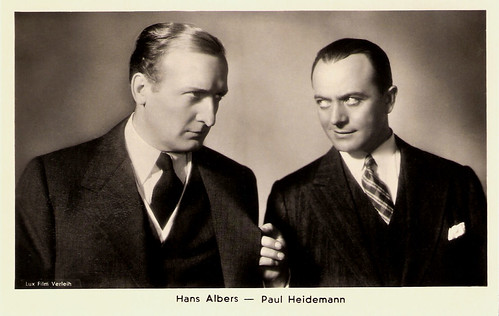
With Paul Heidemann. Austrian Postcard by Iris Verlag, no. 6699. Photo: Lux Film Verleih.

Austrian Postcard by Iris Verlag, no. 6269. Photo: Lux Film Verleih.
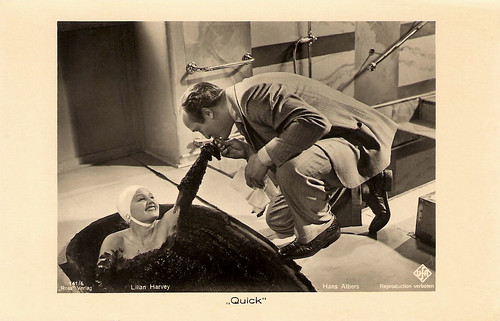
German postcard by Ross Verlag, no. 141/6. Photo: Ufa. Lilian Harvey and Hans Albers in Quick (Robert Siodmak, 1931). Collection: Geoffrey Donaldson Institute.

German postcard by Ross Verlag, no. 6112/1, 1931-1932. Photo: Ufa. Anna Sten and Hans Albers in Bomben auf Monte Carlo (Hanns Schwarz, 1931).

German postcard by Ross Verlag, no. 7766/1, 1932-1933. Photo: Boston-Film. Hans Albers and Luise Rainer in Heut' kommt's drauf an/Today it depends (Kurt Gerron, 1933). This film, now considered lost, was the second film with Luise Rainer.

German postcard by Ross Verlag, no. 8105/2, 1933-1934. Photo: Ufa. Hans Albers in Ein gewisser Herr Gran (Gerhard Lamprecht, 1933).
Big-mouthed strong man
After roles in over one hundred silent films, Hans Albers starred in the first German talkie, the romance Die Nacht gehört uns/The Night Belongs to Us (Carl Froelich, 1929) with Charlotte Ander.
He then played big-mouthed strong man Mazeppa alongside Emil Jannings and Marlene Dietrich in Der blaue Engel/The Blue Angel (Josef von Sternberg, 1930), the film which made Dietrich an international star.
Albers himself shot to fame with Der Greifer/The Snatcher (Richard Eichberg, 1930) about three crooks who are planning a jewel robbery. Albers enhanced his star status with similar daredevil roles in the 1930s.
He was probably at his best when teamed up with Heinz Rühmann, as in Bomben auf Monte Carlo/Bombs Over Monte Carlo (Hanns Schwarz, 1931) and Der Mann, der Sherlock Holmes war/The Man Who Was Sherlock Holmes (Karl Hartl, 1937).
In the latter film Albers and Rühmann play two confidence tricksters who pretend to be the famous duo Holmes & Dr. Watson and the police, gangsters and girls believe them beyond any doubt. Another success was the comedy Quick (Robert Siodmak, 1932) in which he played a clown opposite Lilian Harvey.

German postcard by Ross Verlag, no. 7518/1, 1932-1933. Photo: Ufa. Sybille Schmitz and Hans Albers in F.P.1 antwortet nicht/F.P.1 Doesn't Answer (Karl Hartl, 1932).

German Postcard by Ross Verlag, no. 6833/2, 1931-1932. Photo: Ufa.
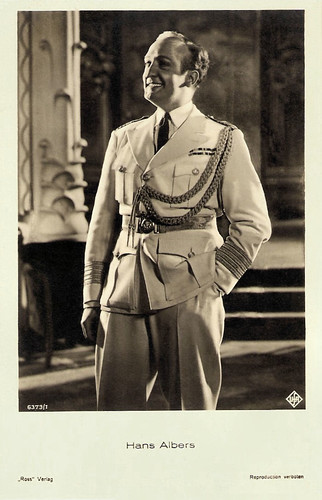
German postcard by Ross Verlag, no. 6373/1, 1931-1932. Photo: Ufa.
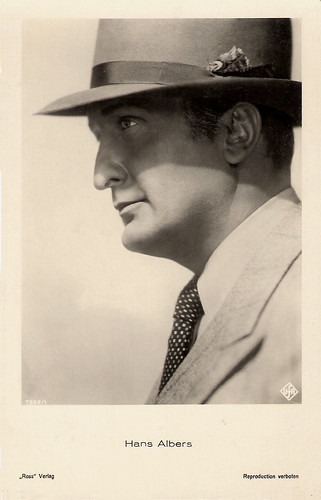
German Postcard by Ross Verlag, no. 7562/1, 1932-1933. Photo: Ufa.
Massive hits
Many of Hans Albers' songs from his films became massive hits and some even remain popular to this day. While Albers himself never supported the Nazi regime, he became the most popular actor of the Third Reich.
Albers was paid a considerable sum of money to star in Ufa's big-budgeted anniversary picture Münchhausen/The Adventures of Baron Munchausen (Josef von Baky, 1943) but was always careful not to give the impression that he was endorsing the National Socialist regime. Joseph Goebbels, Reich Minister of Propaganda in Nazi Germany had commissioned this lavish production as a commemoration of the 25th anniversary of Ufa, the government-run German film association.
More importantly, it was also to be a rival of the great fantasy films which had come from the Allied nations, such as The Wizard of Oz (Victor Fleming, 1939) and The Thief of Bagdad (Ludwig Berger, Michael Powell, Tim Whelan, 1940). On IMDb, Ron Oliver writes: "In that, it succeeds brilliantly and needs no comparison to any other film."
In 1943 Albers also starred in another classic, Große Freiheit Nr. 7/Great Freedom No. 7 (Helmut Käutner, 1943) with Ilse Werner. The film was banned by the censorship of the Third Reich because the story was considered too 'anti-heroic' and demoralising how German sailors and women were portrayed. The film could only be shown outside Germany.
IMDb reviewer Jan Onderwater comments: "From directing till script, from acting till (Agfa colour) photography this is a brilliant film, with everyone involved giving the best of their talents. What we see is a compelling drama, well balanced, psychologically well conceived and at the same time a film that is great fun to watch over and over again. In this film, there are only people and their lives who are not up to standard Nazi definition."
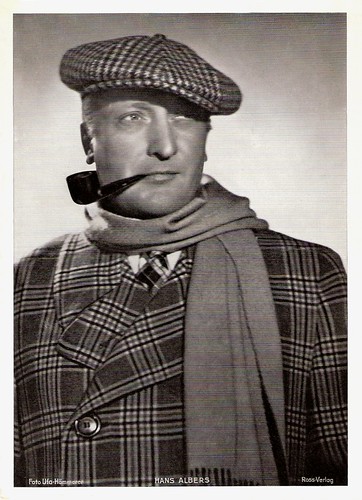
Big card by Ross Verlag. Photo: Ufa / Hämmerer.
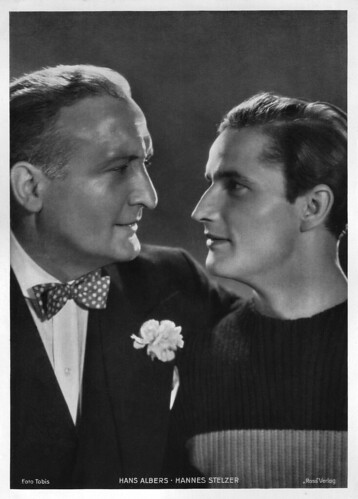
Big German collectors card by Ross Verlag. Photo: Tobis. Hans Albers and Hannes Stelzer in Fahrendes Volk/Travelling people (Jacques Feyder, 1938).
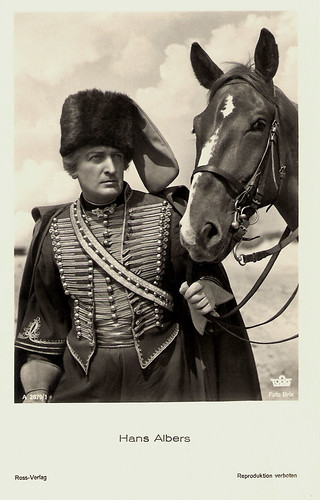
German Postcard by Ross Verlag, no. A 2879/112, 1939-1940. Photo: Brix / Tobis. Publicity still for Trenck, der Pandur/Trenck the Pandur (Herbert Selpin, 1940).

German postcard by Film-Foto-Verlag, no. A 3728/1, 1941-1944. Photo: V. Swolinski / Ufa. Publicity still for Munchhausen/The Adventures of Baron Munchausen (Josef von Baky, 1943) with Hans Albers and Brigitte Horney.
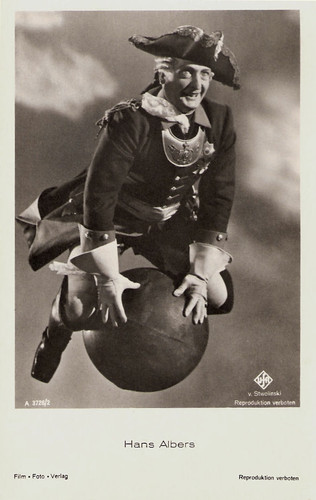
German postcard. Film-Foto-Verlag, no. A 3728/2, 1941-1944. Photo: von Stwolinski / Ufa. Publicity still for Münchhausen/The Adventures of Baron Munchhausen (Josef von Baky, 1943).
St. Pauli
After World War II, Hans Albers matured into character parts to some public and critical acclaim, but he never again enjoyed the huge stardom of the 1930s and early 1940s. One of his better roles of this period was an ageing industry tycoon in Vor Sonnenuntergang/Before Sundown (Gottfried Reinhardt, 1956), which won the Golden Globe as Best Foreign Film of the Year.
On IMDb reviewer Diger Jantzen notes: "Hans Albers' performance is heartbreaking from the start until the end and it is clearly one of his best serious performances ever." Albers' final film was the crime comedy Kein Engel ist so rein/No Angel Is That Pure (Wolfgang Becker, 1960) with Sabine Sinjen.
Today he is probably more known for his music than his films, and his music is still widely-known in modern Germany, even among young people. Many of Albers' songs were humorous tales of drunken, womanising sailors on shore leave, with double entendres such as "It hurts the first time, but with time, you get used to it" in reference to a girl falling in love for the first time. Albers' songs were often peppered with expressions in Low German, which is spoken in Northern Germany.
His most famous song is by far 'Auf der Reeperbahn nachts um halb eins' (On the Reeperbahn at half past midnight) which has become the unofficial anthem of the colourful neighbourhood of St. Pauli. The Hans-Albers-Platz, one block south of the Reeperbahn, has a statue of Albers, by the German artist Jörg Immendorff. Outside of Northern Europe, however, Albers remains virtually unknown, although the image of an older man in a seaman's cap and raincoat playing accordion and singing may be recognised by many outside of Germany, even if they don't know that this image is based on Hans Albers.
As a case in point, McDonald's used such an image in an American television ad campaign in 1986. In reality, Albers had no experience on the water, this being restricted to a one-day trip to Helgoland. Hans Albers died in Kempfenhausen, Bavaria, in 1960. After his death, the Wilhelmplatz, a square in St. Pauli, was named after him. In 1989, Hans Albers was the subject of a biographical docudrama, In Meinem Hertzen Schatz/In My Heart's Treasure.
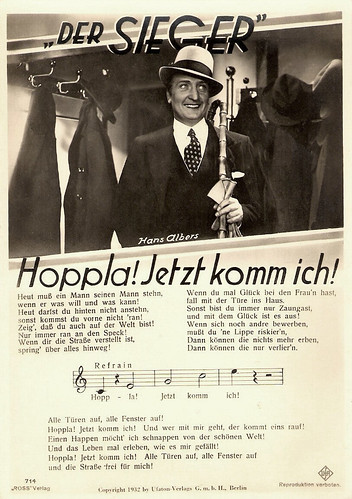
German Postcard by Ross Verlag, no. 714, 1932. Photo: Ufa.

German postcard by Ross Verlag, no. 7768/1, 1932-1933. Photo: Boston-Film.

Dutch Postcard by JosPe, no. 545.
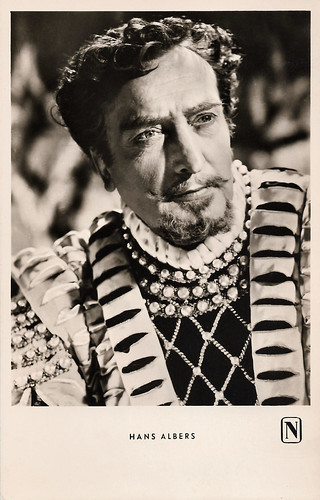
West German postcard by Kunst und Bild, Berlin, no. A 441. Photo: Nationalfilm. Hans Albers in Barbe-Bleue/Blaubart/Bluebeard (Christian-Jacque, 1951).
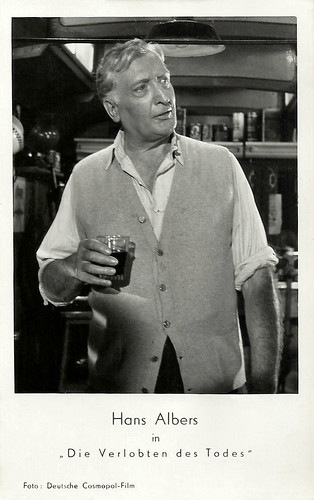
German postcard. Photto: Deutsche Cosmopol-Film. Publicity still for Die Verlobten des Todes/I fidanzati della morte (Romolo Marcellini, 1957).

West German postcard by Ufa/Film-Foto, Berlin-Tempelhof, no. FK 3987. Photo: Wesel / Kurt Ulrich Film / DFH. Hans Albers in Der Greifer/The Ripper (Eugen York, 1958).
Sources: Hal Erickson (AllMovie), Thomas Staedeli (Cyranos), Filmportal.de, Wikipedia and IMDb.
No comments:
Post a Comment